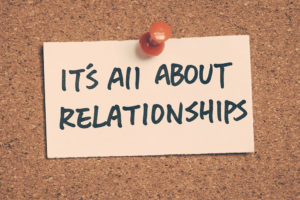I bet you have more needs at your nonprofit than you can shake a stick at.
You have programs that need to be funded, special projects to undertake and maybe equipment or vehicles you’d like to buy.
Sometimes you can get a foundation to fund those particular needs, but most of the time, the most effective and efficient use of your time is creating a major gifts campaign to raise that money. 
Yep, I’m talking about getting face-to-face with a donor, telling them the story, then asking for a gift. As far as return on investment, there’s not much you can do that will bring in more results for the investment of time you put into it.
The biggest question most people have is “How do I get started?”
Planning a major gifts campaign
Are you planning to get major gifts? Or are you waiting for a major donor to just pop up with a large gift?
It’s the difference in being proactive versus being reactive.
If you really want to get the most ‘bang for the buck’, plan to spend some time cultivating your top 10 donors this year.
It can be intimidating to get major gifts when you’re just starting out in fundraising. But here’s the scoop: it’s all about building relationships.

Think about your best friend and how your relationship started. You probably weren’t best friends from the first moment you met. It took time for it to develop.
It’s a lot like that with donors.
Before you begin a major gifts campaign
You don’t want to just jump right in and ask someone for money before you’ve thought through a couple of things.
Here are the 3 basic steps you need to take in planning for unique type of fundraising.
1. The first thing you must do is determine the need. Be specific here. What is it that you need to raise money for? Is it a new program? Or an expansion of an existing program? Do you need a specific piece of equipment? Get very clear about the specific need you want to address with a major gifts campaign.
2. Next, outline the cost. What will it cost for the program or project? Be sure to include both direct and indirect expenses. In other words, if you need a new vehicle to transport clients, don’t just include the cost of the vehicle – also include tags, title, license, insurance, maintenance, and the staff driver’s time.
3. Finally, before you approach any donor, get your case for support ready. Be ready to answer the donor’s questions about the program or project and why they should support it.
Finding major donor prospects
Here are four simple steps to success in identifying major donor prospects:
1. Look for LIA (Linkage, Interest, Ability). A donor must have all three or you just won’t be able to get a major gift from them. Linkage to your organization can come in lots of forms from past volunteer experience to knowing someone on your Board to simply caring about your cause. Your donor must be interested in the work you’re doing, and they must have some ability to give (think disposable income). The combination of these three things is what brings about a gift.
2. Do your homework. Find out all you can about your prospective donor. Learn about their family, their hobbies and what other charities they support. And, find out why they support YOU!
3. Match the donor’s interests with a program/need you have. A “hand-in-glove” fit will help ensure you get the gift and that the donor has a satisfying experience making the gift. If the donor is interested in your after school program, then don’t ask them to support your food pantry.
4. Make the ask. Ask for a specific amount – not a range. If the donor whips out the checkbook, you asked too low and left money on the table. The ideal answer is “I’ll need to check with my _____(spouse, accountant, financial planner, etc.).”
The best thing you can do is practice. The more you work on cultivating major donors, the better you’ll get and the more major gifts you’ll get.
The Bottom Line
Starting a major gifts campaign doesn’t have to be hard or complicated. I’ve found over the years that many of us want to make major gift work much scarier than it really is.
Just remember this: these donors care very much about your organization and WANT to see you be successful. Treat them like the best friends your nonprofit has and you’ll soon be beaming with pride at your winning major gifts campaign.






Hi Sandy!
We ‘Connect kids to nature and wildlife through the ‘ARTS’! Exciting hands-on projects with live animal models in the classroom or we take the kids out in the wild with us!! Founded in 2005, struggling to support the programs, everyone told us if we were a 501c3 non profit we would be eligible for all kinds of grants! Wildlife Conservation Grants, Education Grants, ABC Grants, because we fall under such a wide range, but after several ‘YEARS’ of writing grants and being turned down, the wind is going out of our sail, sadly…I’ve spent my own money to keep us alive this year. I’ve read every free piece of advice you can give, can’t afford the big stuff. I’m just at the end, everybody loves Painting With Pat, the kids are becoming future wildlife conservationists, their eyes are opening to the world around them through our projects, and I don’t want to shut the door. What do I do?
Pat
Pat, you need to find a few folks who believe as you do in the importance of the work you’re doing. They’ll be willing to help you. And the way you find them is to talk to lots of people about the work you’re doing. When someone seems interested, invite them to take the next step to become more engaged and support your work. Be careful not to come across as desperate – that will push people away.
Sandy
great article…!